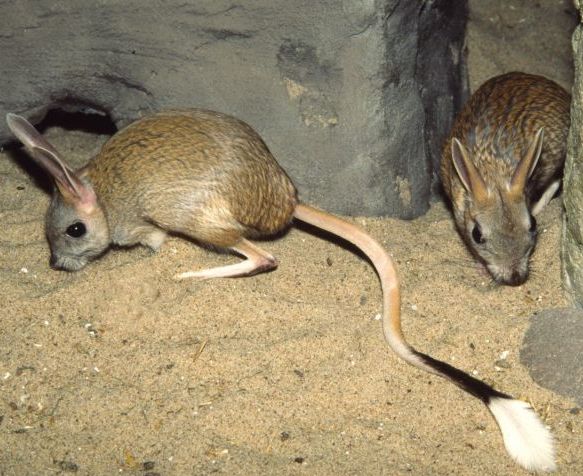
Great jerboa (Allactaga major)
Phylum — chordata
Class — mammalia
Order — rodentia
Family — dipodidae
Genus – allactaga
Appearance
The Great jerboa is the biggest of all species of jerboa. The length of its body is 180 mm and its tail is 260 mm.
Great jerboas possess the body of a gerbil with long ears, elongated five-toed hind legs and rabbit-like long ears. Their color is a sandy brown with a pale belly, chest and legs. Their eyes appear very large in comparison to the rest of the head. The eyes need to be so large in order for the great jerboas to navigate at night. The tail is much longer than the rest of the body. It is very slim with a white and black tuft at the tip.
Habitat
It is found in Kazakhstan, Russia, Turkmenistan, Ukraine and Uzbekistan.
Behavior
These animals live in small family colonies. Great jerboas spend their days sleeping underground in long burrows and chambers. Underground is much cooler than the searing heat outside. They awake during sunset.
They search far and wide to find seeds, roots, bulbs and insects. They obsessively comb through the sand with the toes of their forefeet to find food. Great jerboas have to eat whatever they find instead of saving food for later.
Diet
Great jerboas feed on seeds and insects.
Reproduction
Breeding takes place in late spring and summer during which time there may be two litters, each of about three to six young.
The typical lifespan of a jerboa is around six years.
In captivity
Keep jerboa in a cage or a terrarium. It will be more interesting to watch them in a terrarium, where the desert landscape is reproduced for them. You can change the animals` day and night for the convenience of observing them, at night the cage is illuminated with daylight, and in the day - red. At the bottom of the terrarium or the cage the owner should place a calcined sand layer of 3 cm. The cleanliness of the sand should be monitored. It is not recommended to let the animal go out of the cage, as it will immediately hide under the furniture, and at night it will gnaw and dig up the wall.
The animals need a sand bath. The toilet for animals is arranged in one particular place, so it is not difficult to monitor the cleanliness.
Nests are arranged in small flower pots, you can place there pieces of pipes (not iron). The material for the nest is hay. Preparing for hibernation is the same as for ground squirrels. It`s better to keep animals in couples. In good conditions they breed in captivity.
Jerboa are fed with seeds of cultivated and wild cereals, sunflowers, beets, adult insects and their larvae, as well as crackers from white bread. Jerboa drink a little.
 Russian
Russian
 English
English
























